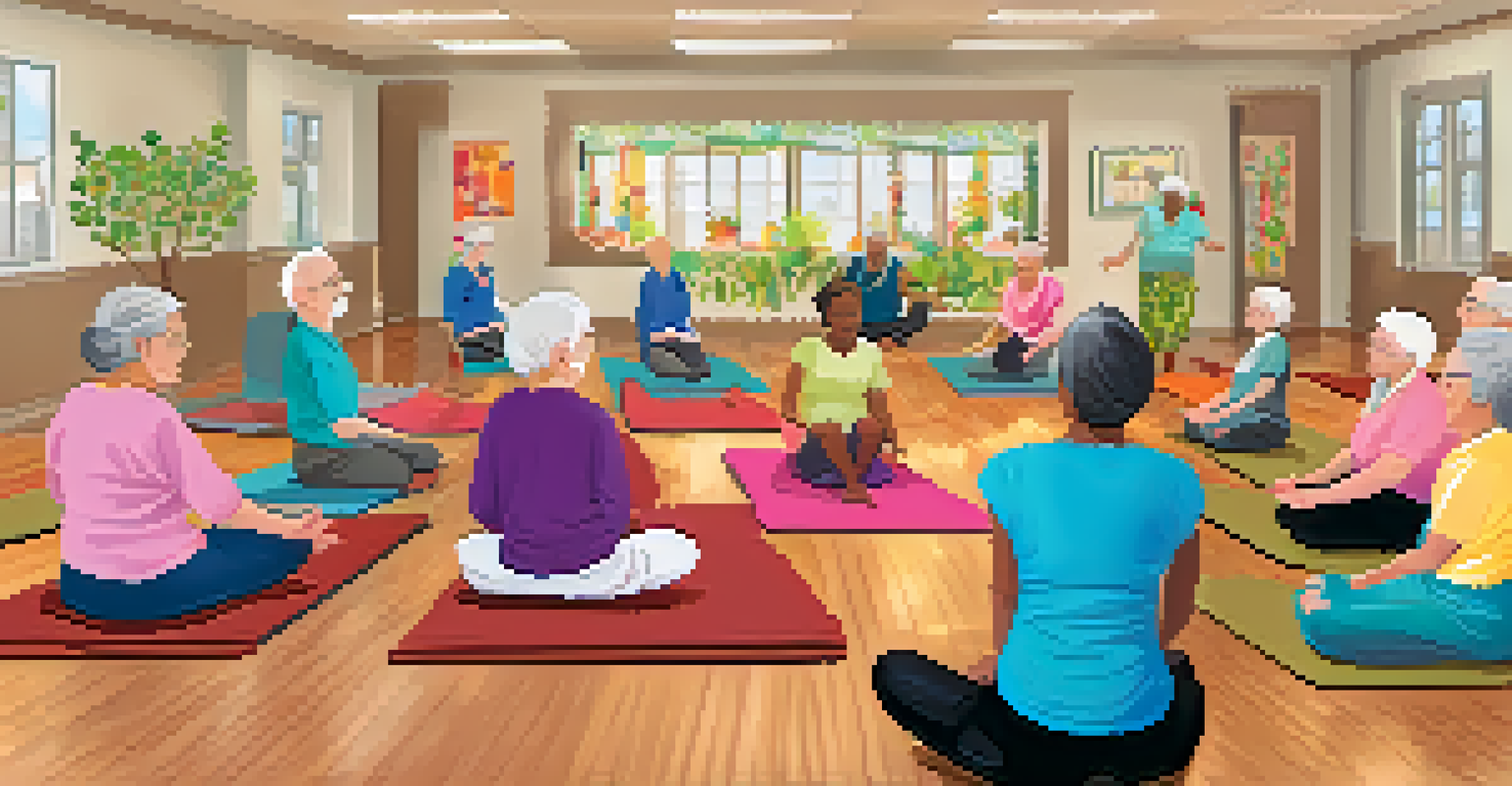Chair Yoga: A Guide for Caregivers Supporting Limited Mobility

Understanding Chair Yoga and Its Benefits
Chair yoga is a gentle form of yoga designed for individuals with limited mobility. It allows participants to perform yoga poses while seated, making it accessible to those who may find traditional yoga challenging. This practice not only promotes physical flexibility and strength but also fosters mental relaxation and mindfulness, enhancing overall well-being.
Yoga is not about touching your toes, it’s about what you learn on the way down.
For caregivers, understanding chair yoga is essential as it provides a tool to encourage physical activity in those they support. Many individuals with limited mobility often feel discouraged or overwhelmed by traditional exercise options. Chair yoga creates an inclusive environment where they can engage in movements that feel safe and achievable.
Moreover, chair yoga can lead to improved circulation, better posture, and increased range of motion. These benefits are particularly crucial for individuals recovering from surgery or managing chronic conditions. By integrating chair yoga into daily routines, caregivers can help their loved ones feel empowered and more in control of their health.
Getting Started: Essential Chair Yoga Poses
Before diving into chair yoga, it's important to familiarize yourself with some foundational poses. Simple movements, such as seated cat-cow, seated forward bend, and wrist stretches, can be a great starting point. These poses help to loosen tight muscles and improve flexibility without requiring participants to leave their chairs.

When introducing these poses, focus on slow, controlled movements to ensure safety. Encourage deep breathing, as this can enhance relaxation and help participants connect with their bodies. Offering modifications is also key; not everyone will be able to perform a pose in the same way, so providing alternatives can make a significant difference.
Chair Yoga for All Abilities
Chair yoga offers a gentle, accessible way for individuals with limited mobility to engage in physical activity and enhance their well-being.
As caregivers, you can lead by example. Demonstrate the poses yourself or use visual aids to guide your loved ones. This not only helps them understand the movements better but also creates a shared experience that can strengthen your bond.
Creating a Comfortable Practice Space
A comfortable practice space can greatly enhance the chair yoga experience. Choose a quiet, well-lit area with minimal distractions to help participants focus on their movements. Adding personal touches, like soft music or calming scents, can create an inviting atmosphere that promotes relaxation.
The mind is everything. What you think you become.
The choice of chair is also crucial. Make sure the chair is sturdy, supportive, and at an appropriate height for easy transitions in and out. Ideally, the chair should have armrests to assist with balance and stability during exercises.
Don’t forget to include props such as yoga blocks or straps, which can aid in achieving poses without strain. Encouraging participants to customize their space with items that bring them joy, like a favorite blanket or photograph, can further enhance their comfort and engagement.
Incorporating Mindfulness into Chair Yoga
Mindfulness is a key component of yoga, and chair yoga is no exception. Encourage participants to focus on their breath and be aware of their body's sensations during poses. This practice of mindfulness can help reduce anxiety and promote a sense of calm, which is especially beneficial for those facing health challenges.
You can facilitate mindfulness by guiding participants through short meditative moments between poses. For example, ask them to close their eyes and take a few deep breaths, tuning into how their body feels. This simple practice can ground them, helping to create a deeper connection with their movements.
Creating a Safe Practice Space
Establishing a comfortable and distraction-free environment is essential for a positive chair yoga experience.
Additionally, sharing positive affirmations or intentions before starting the session can set a mindful tone. This not only encourages a positive mindset but also reinforces the idea that their practice is about self-care and personal growth.
Safety Considerations for Chair Yoga
Safety should always be a top priority when practicing chair yoga, especially for individuals with limited mobility. Before starting any session, make sure the participant is in good health and consult a healthcare professional if needed. Knowing their physical limitations will guide you in choosing appropriate poses.
It’s also essential to encourage participants to listen to their bodies. If someone feels discomfort or pain during a pose, remind them to stop and adjust their position or skip that exercise altogether. This helps to foster a more positive and safe experience.
Creating an open dialogue about safety can empower participants. Encourage them to voice any concerns or questions, ensuring they feel comfortable and supported throughout their practice.
Establishing a Regular Chair Yoga Routine
Establishing a regular chair yoga practice can yield significant benefits over time. Aim for short sessions, even just 15-30 minutes, several times a week. Consistency is key; regular practice can improve mobility, enhance mood, and contribute to overall physical health.
To help establish this routine, consider scheduling specific days and times for chair yoga sessions. This can create a sense of structure and expectation, making it easier for participants to engage. You could even turn it into a social activity by inviting others to join, fostering community and support.
Mindfulness Enhances Yoga Benefits
Incorporating mindfulness practices during chair yoga can help reduce anxiety and foster a deeper connection to one’s body.
Celebrating small milestones along the way can also motivate participants to stick with the routine. Whether it's mastering a new pose or simply feeling more relaxed, acknowledging these achievements can encourage continued practice.
Resources for Caregivers and Participants
There are numerous resources available to help caregivers and participants get the most out of chair yoga. Online platforms offer guided chair yoga classes, making it easy to find sessions that suit various skill levels. These resources can be a great way to learn new poses and techniques.
Books and instructional videos can also serve as valuable tools for caregivers looking to enhance their skills. Many of these resources provide step-by-step guidance, making it easier to introduce chair yoga to participants. They can also inspire caregivers with new ideas and variations to keep sessions fresh and engaging.

Lastly, connecting with local yoga studios or community centers can be beneficial. Many offer specialized classes for seniors or individuals with limited mobility, providing a supportive environment for participants to practice alongside peers.